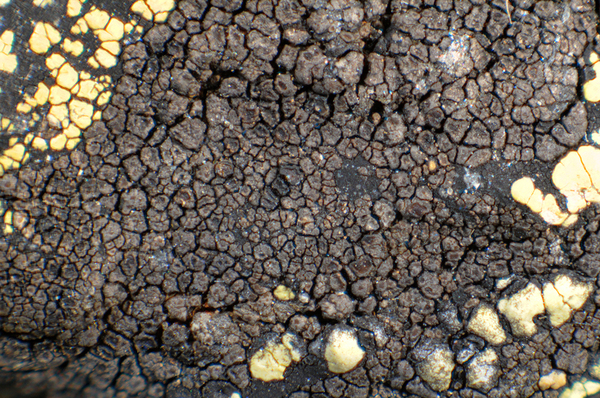Miriquidica instrata (Nyl.) Hertel & Rambold
Mitt. bot. Staatss. München, 23: 385, 1987. Basionym: Lecidea instrata Nyl. - Flora, 60: 224, 1877.
Synonyms: Biatora instrata (Nyl.) Arnold; Lecidea subobscura H. Magn.
Distribution: N - TAA (Nascimbene & al. 2022), Lomb (Nascimbene & al. 2021). C - Sar (Nascimbene & al. 2021).
Description: Thallus crustose, episubstratic, minutely areolate, often starting the life-cycle on the thalli of other crustose lichens, the areoles irregularly rounded to angular, concave to flat, 0.3-1(-3) mm wide, brown to brown-black, waxy-dull, often with a paler, greyish margin, developing on a dark hypothallus. Medulla white, I-. Apothecia rare, at first immersed in the areoles and almost aspicilioid (surrounded by a kind of 'thalline margin'), then slightly prominent, rounded to irregular in outline, 0.3-0.5(-0.7) mm across, with a black to brown-black disc and an thin, often indistinct proper margin. Proper exciple thin, poorly developed, greenish brown to olive brown in outer part, colourless to yellow-brown within; epithecium brown to olive-brown, 13-18 µm high; hymenium colourless, (35-)34-65(-75) µm high, I+ blue; paraphyses coherent, 1.5-1.7(-2.5) μm thick at mid-level, the apical cells 2-4.5(-6) μm wide; hypothecium colourless or yellowish. Asci 8-spored, clavate, approaching the Lecanora-type, but with a weakly amyloid tholus, lacking an amyloid zone above the axial body and with a thin outer amyloid wall layer. Ascospores 1-celled, hyaline, broadly ellipsoid, (7-)9-13(-16) x 4-7(-8) µm. Pycnidia black, immersed. Conidia thread-like, curved, 20-22 x c. 0.5 µm. Photobiont chlorococcoid. Spot tests: cortex and medulla K-, C-, KC-, P-. Chemistry: miriquidic acid. Note: on siliceous rocks, with optimum above treeline, sometimes starting the life-cycle on other crustose lichens; probably more widespread in the Alps.
Growth form: Crustose
Substrata: rocks
Photobiont: green algae other than Trentepohlia
Reproductive strategy: mainly sexual
paras crustose lichens (facultatively)
Commonnes-rarity: (info)
Alpine belt: rare
Subalpine belt: very rare
Oromediterranean belt: very rare
Montane belt: absent
Submediterranean belt: absent
Padanian area: absent
Humid submediterranean belt: absent
Humid mediterranean belt: absent
Dry mediterranean belt: absent

Predictive model
Growth form: Crustose
Substrata: rocks
Photobiont: green algae other than Trentepohlia
Reproductive strategy: mainly sexual
paras crustose lichens (facultatively)
Commonnes-rarity: (info)
Alpine belt: rare
Subalpine belt: very rare
Oromediterranean belt: very rare
Montane belt: absent
Submediterranean belt: absent
Padanian area: absent
Humid submediterranean belt: absent
Humid mediterranean belt: absent
Dry mediterranean belt: absent

Predictive model
 INDEX FUNGORUM
INDEX FUNGORUM
 GBIF
GBIF
 DOLICHENS
DOLICHENS


